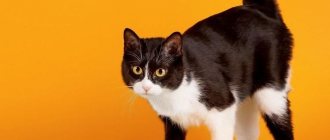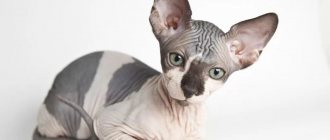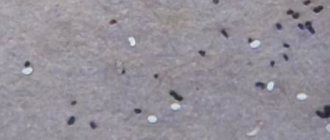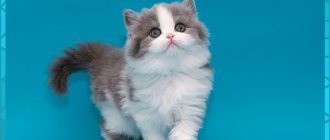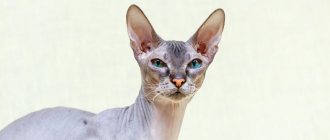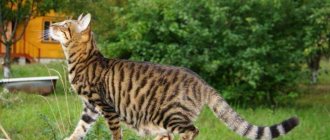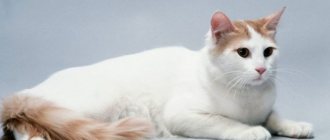The combination of black and white on a cat's coat is found in both outbred and purebred cats. This color is called black bicolor , and there are different color combinations.
For the first time, a black and white cat was presented at the world felinological exhibition in 1969, where several individuals officially performed, and previously this coat color was considered a defect. Since then, bicolors have become popular and are found in most cat breeds .
Features of the colors of black and white cats
An animal with this coloring is unique: it is impossible to meet cats with the same arrangement of markings on the body . More often there is an asymmetrical coloration of the fur coat. Individuals with a symmetrical pattern are rare and therefore are more valuable.
Interestingly, black spots are not only on the coat, the nose and paw pads are partly dark and partly pink.
The beautiful iris of the eyes also attracts attention. For most it is green or yellow. Sometimes heterochromia occurs, when the white half of the muzzle has a blue or amber-yellow eye, and the black half has a green eye.
Bicolor cat breeds
Black and white coloring is found in both “mongrels” and purebred animals. There are a number of breeds in which bicolor kittens are quite common.
British cat
Bicolor color among British cats is quite widespread and can have many different variations. Black and white representatives of this breed look especially impressive. The contrasting color, reminiscent of a tuxedo, gives them an aristocratic look.
British bicolors must have white muzzle, collar, hips and “slippers” on their paws
In the professional language of felinologists, white spots in the British are called Piebald Spotting (“piebald spotting”).
In addition to the officially recognized bicolor colors, the British have a mitted color. Its distinctive feature is a white stripe running from the chin to the chest, a white groin and belly, and sometimes you can see white “socks.” Mitted is considered a breed fault.
Basic color requirements for two-color British cats:
- uniform distribution of color spots;
- unblurred boundaries between contrasting patterns;
- absence of moire and unpainted hairs;
- eye color: orange;
- amber;
- In Van and Harlequin cats, heterochromia is acceptable.
The character of British motley cats is as contrasting as the color of their coat. These cute creatures allow you to do anything to yourself that does not humiliate their feline dignity. The British love their owners sincerely and tenderly, but will never force their love on them. They are always nearby, but at a certain distance. Pets are unobtrusive, clean and smart. Cats enjoy the presence of their owners, but calmly tolerate their absence. British Bicolors are quite tolerant of animals and small children, but at times they need privacy.
Video: British bicolor kittens
Scottish cat
Scots have an impressive range of colors, in which the bicolor color has found its niche. The general requirements for white piebald colors for the Scots are the same as for the British - the correct distribution of white and colored areas. True, Scottish folds are a little inferior to their British relatives in the clarity of borders and symmetry of the pattern.
The black and white pattern gives the Scottish cat an extraordinary charm
Breed characteristics characteristic of bicolor Scots:
- eye color: copper;
- rich orange;
- heterochromia is acceptable.
Experienced breeders notice that the character of Scottish dogs is in some way interconnected with the color of their coat. Blue individuals are quite obstinate. This is explained by the fact that British genes “rage” more strongly in them. And animals of black and white color are more affectionate and flexible.
In general, Scottish cats are distinguished by a stable psyche, gentlemanly restraint and an accommodating, peace-loving character. They are unpretentious in everyday life and are well disposed towards children and animals. Scots are not aggressive, but can fight back if necessary. Independent by nature, pets of this breed do not like close tactile contact and show signs of love themselves. They don’t get bored alone if you leave them everything they need.
Persian cat
Persian cats are famous not only for their luxurious coat, but also for their rich color palette. Black and white Persians are by no means lost in this motley list.
Until recently, quite strict requirements were imposed on the two-tone color. In the modern world, the only necessary condition for bicolor Persians is that two contrasting colors be in a certain proportion .
Pedigree differences of the Meglai Persian cat:
- spots should not occupy more than 2/3 of the total area, white wool - more than 1/2;
- eye color: copper;
- dark orange;
- blue;
- heterochromia is acceptable.
- pink;
Black bicolor Persians are deservedly popular among cat lovers
Phlegmatic and sedentary, Persian cats do not need frequent active games, although occasionally they are not averse to chasing a ball around the house. Instead, they can spend hours looking out the window or lying on the sofa. Persians are absolutely good-natured and unforgiving creatures that fit perfectly into the company of people and animals living in the same territory. Cats of this breed need constant care, so they will become faithful companions for lonely and underemployed people.
Video: adorable bicolor Persian
Maine Coon
In addition to their impressive size and memorable appearance, Maine Coons are famous for their wide range of colors. Bicolor colors are quite common in this breed.
Maine Coons are a native breed, so there are many more acceptable black and white combinations than other cats.
Classification of black and white Maine Coon color:
- white gloves - the presence of white “socks” or “slippers” on the paws;
- snow-white medallion - the presence of white marks on the chest that resemble a shirtfront;
- colored buttons - the presence of small round spots with clear outlines;
- bicolor - dark spots dominate over white ones;
- harlequin - white color takes up no more than half of the area;
- van - the coat is almost white, with the exception of a few spots and a completely colored tail;
- tuxedo - a set of white gloves and a white medallion, visually reminiscent of the men's outfit of the same name.
External differences of bicolor Maine Coons:
- any shades of the iris are allowed;
- The paw pads and tip of the nose are in harmony with the shade of the animal.
Despite their large size, the character of Maine Coons is quite friendly, calm and affectionate. They easily get along with pets and children of any age group. Preference is given to one owner, who, thanks to his intelligence and attention, is understood at a glance. Cats are incredibly active and playful, so they need a spacious room for an active life.
Video: bicolor Maine Coon
Angora cat
Previously, all representatives of the Turkish Angora breed had exclusively snow-white fur and incredible ultramarine eyes. Felinologists decided to expand the range of Angora colors and, by infusing the blood of other breeds, bred cats of various color combinations, including black bicolor.
Black and white Angoras look no less impressive than their monochrome relatives
Breed characteristics of the black and white angora:
- implies the presence of: a light inverted V between the eyes;
- snow-white paws, chest, muzzle (white belly and shirtfronts are allowed).
- blue;
The Angora cat is a very friendly and restless animal. Cats have a fine mental organization and cannot tolerate rudeness and violence. They are very sociable and thrive in the company of other animals. Young children are treated with tolerance, but they are not shown much love. Pets are distinguished by their innate intelligence and quick wit. They treat all family members with respect, but preference is given to one owner.
Canadian Sphynx
Canadian sphinxes, despite their extraordinary appearance, have long found their admirers. The delicate wrinkled skin, the bewitching look of expressive eyes and large ears, like those of a bat, attract special attention to the breed.
In Canadian Sphynxes, not only the barely noticeable pubescence on the body is colored, but also the skin
In the bicolor color of the Canadian Sphynx, any ratio of contrasting colors is recognized. The black shade of suede skin is closer to an intense gray color, and the white shade is closer to light pink or cream.
External features of bicolor sphinxes:
- the color of the iris of the Sphynx's eyes is not tied to the main color of the coat and can be anything;
- The paw pads and mirror match the main color of the skin (pigmentation in the form of black spots is acceptable).
Sphinxes have a cheerful and curious disposition. They get along well with children and patiently endure even involuntary rudeness. They often choose their favorite owner and prefer to spend all their time with him. Without proper attention, pets begin to suffer, may refuse to eat and even get sick. Sphynxes are one of the most talkative animals. They accompany all their actions with sounds. It is not advisable for busy people to have such pets.
Siberian cat
The Siberian cat is the real pride of Russian felinologists. This luxurious breed comes in the most incredible colors. Fluffy two-color beauties are deservedly popular.
The main requirement for the double colors of the Siberian cat:
- correct distribution and ratio of white and colored areas;
- eye color of black bicolor Siberians: green;
- yellow.
- pink;
Siberian black bicolors have the most incredible, cheerful and expressive colors
Siberian cats have a proud and independent character, but with the right approach they become the most devoted and affectionate friends to their owners. Siberians amaze with their intelligence - they understand family members literally, although they rarely speak up themselves. These are active and sociable pets. They enjoy communicating with children and animals living under the same roof. Siberian cats do not like familiarity, so you can win their love only with delicacy and tact.
Kurilian Bobtail
Kurilian Bobtails are a relatively young breed, but the animals can compete with the most common cat “brands”. Bobtails are easily recognized by their short, docked tail, shaped like a pompom.
The play of white and black colors creates the most unusual patterns on the bobtail’s fur.
Almost all colors are allowed by the standard. Black bicolor for animals is not a rare exotic color.
Breed differences of black and white bobtails:
- white inclusions of varying sizes are allowed in any area of the body;
- black and white pet eye color: green;
- yellow;
- blue;
- heterochromia is acceptable.
Kurilian Bobtails are called dogs in cat form. Indeed, in their behavior they resemble dogs. Pets are brave, fearless and have a loyalty to their owner that is atypical for cats. Bobtails easily find contact and get along well with animals and children. According to numerous statements, representatives of this breed are able to relieve stress and fatigue with their presence.
Munchkin
Munchkins are the shortest-legged members of the cat family. In the breed standards for dachshund cats, all colors and combinations are acceptable. This is another selective breed where black and white bicolor is very popular.
The ancestor of the munchkins was a black and white cat, so bicolor coloring is very common in this breed
Characteristics of black bicolor munchkins:
- black bicolor is most often presented in approximately the same combination of dark and light areas;
- in bicolor, the pigment of the eyes does not depend on the color of the animal’s coat;
- The color of the paw pads and nose mirror depends on the main color of the cat.
Munchkins are cheerful, active and inquisitive animals. Cats have incredible intelligence that helps them keep themselves occupied. Munchkins are very loyal to children and animals, they become attached to all household members, but they choose one owner for themselves. Pets love to be in a large and noisy company, but absolutely do not suffer alone.
Many munchkins have a tendency towards kleptomania: they, like magpies, love to hide shiny and small things in secluded places, so that they can later take them out and play with them.
Manx
Manx are the aboriginal inhabitants of the Isle of Man. Their main external feature is the absence of a tail. Manx cats have a downy, soft coat that feels like rabbit fur to the touch.
Among the representatives of this breed, any colors are possible, except those that appeared as a result of selection. The black bicolor is recognized by the association and is in great demand among Manx breeders and fanciers.
Breed characteristics characteristic of black and white individuals:
- eye color: yellow;
- tea;
- orange;
- green.
Black and white bicolor favorably emphasizes the beauty of the Manx's down coat
Manxes are very sociable and social pets. They find a common language and communicate well with all household members. Cats love small children and willingly participate in their games. Representatives of this breed are extremely affectionate, peaceful and unforgiving. Manxes are the best option for those who need a loyal friend and reliable companion.
Classification of black and white cat colors
The bicolor colors are surprisingly diverse and it is impossible to find two identical animals.
But, despite the difference in colors, the main types of color arrangement have been identified and the classification is carried out taking into account a number of features of the animal’s color:
- number of white spots ;
- character of the drawing.
Any eye color is allowed. Most often these are green, but blue and all shades of yellow are allowed. Heterochromia is not considered a disadvantage.
By the number of light spots
The ratio of light to dark tones is determined.
Regardless of the picture, there are 3 groups:
- Minimum . Up to 40% white on the coat.
- Average. 40-60%. Here the ratio of colors is approximately equal or one slightly prevails over the other.
- White predominance (more than 60%). These are light cats with a dark pattern on their fur. Sometimes there may be several small black spots.
Be sure to read:
Are there tricolor cats or only cats: genetics, which breeds are typical, probability
In addition to the color ratio, pay attention to the symmetry of the marks .
According to a pattern of white spots
A more detailed classification determines not only the color ratio, but the location and nature of the pattern.
This scale has a conditional division into 9 groups:
- No visible stains. The black coat has areas of light hair. They look like small blotches or blurry strokes.
- Medallion drawing. Characteristic are small white areas under the chin on the neck, often complementing the “slipper” coloring on the tips of the paws .
- Mark on the neck. It starts under the chin and is large in size. Looks like a tie or shirtfront.
- The light area begins under the chin and continues to the neck area. May affect part of the muzzle.
- Slightly similar to the previous version, but the light area is larger. It affects the chin and abdomen and can spread to the paws.
- Snow-white cat with large spots on his back. Black markings are present on the head and are located along the ridge, partially covering the sides; the tail is dark.
- Light tone predominates. Small black spots on the head , back, tail.
- This type is called residual black. The snow-white coat has several small spots on the head and tail.
- Dominant white. Only a slight dark shade , sometimes appearing on the snow-light coat, indicates that the cat is a carrier of the black-and-white color gene.
Any color combination looks impressive. Black and white cats are amazingly beautiful, and the unique arrangement of spots gives them individuality.
Features of coloring
The combination of black and white in cats has a number of features. Among them are the following:
- Uniqueness. This coloring can be called unique, since it is impossible to meet two identical black and white cats. Multi-colored spots will always have different locations.
- Spread of color to paws. Seals with light and dark coats may have two-colored pads on their paws. One part of them is painted in dark colors, and the second part is painted pink.
- Unusual eye color. Most cats with black and white fur have unusual eyes that are colored green. Sometimes there are animals in which each eye is painted a different color.
Cat with black and white fur
Additional Information! Most often there are cats with asymmetrical two-tone coloring. Breeds with symmetrical colors are quite rare and expensive.
Types of black and white cat colors
There are 3 common types of colors in domestic purrs:
- Wang . White fur covers almost the entire body . The tail is dark, and there are also several spots on the muzzle and near the ears. A small mark is allowed on the shoulder, paw or side. The color combination looks beautiful and unusual.
- Harlequin. Dark spots are randomly located on the snow-white fur. The shape can be similar to the outline of a heart, fruit, or look like slightly blurred stripes. There are no light areas inside the black markings.
- Bicolor. A common variation where black predominates. Light spots on the chest and may be on the belly and paws.
Be sure to read:
Colors of Scottish cats: description, features, rare colors of folds
In addition to these common types, two more varieties : cap and saddle and raincoat. In the first case, the upper part of the head is colored and a large spot is located in the middle of the back (saddle), and in the second, the outlines of the head and body are dark, reminiscent of a cape with a hood.
The photo shows a cat with a cap and saddle color.
Three types of colors
Jack Russell Terrier: black, white, brown, tri-color and other colors
There are three types of black and white colors that are most often found in pets:
- Wang. In such animals, most of the undercoat is white. Dark fur predominates in the tail area, behind the ears and sometimes above the eyes. Blackish spots can also be seen on the sides or paws. Cats with this coloration look very beautiful and therefore they often take part in exhibitions.
- Bicolor. A characteristic feature of such wool is the predominance of dark color. This type of coloring includes black cats with a white chest. Sometimes areas of light fur are located on the chin or paws. Light spots can be different and differ in size.
- Harlequin. This type of color resembles bicolor, since it also has a predominant light shade. Dark spots are randomly located throughout the cats’ bodies. The spots may differ from each other in shape. Sometimes they resemble certain symbols or figures.
Bicolor is the most common color of two-color pets.
Black and white cat breeds
All breeds are subject to the same requirements regarding the number of spots and the nature of the pattern.
Sometimes there may be small clarifications:
- Maine Coon. Some felinological standards specify that black and white cats must have white areas on all four paws.
- Siberian . All colors are acceptable.
- Sphinxes . These cats have short hair (up to 2 mm) and color varies according to skin tone. In winter they are gray-white, and in summer they tan in the sun and darken. There are no strict color standards.
- Kurilian Bobtails. All color combinations are allowed. If the color is bath or harlequin, then odd-eyed is preferable.
- Siberian . Due to the long, thick coat, color transitions are perceived blurry. This is allowed by the standards.
- Scottish Straight and Fold. Symmetry is desirable, but it is rare. More often, cats with an asymmetrical pattern arrangement participate in exhibitions.
Black and white colors are still unacceptable for a number of breeds. It cannot be found in Siamese, Thai and Abyssinian cats, as well as in some other species where the tabby color is recognized as the official color.
Popular breeds
There are a huge number of different breeds of cats with unusual two-tone colors. However, only eight of them are popular among pet lovers.
Cornish Rex
Black Spitz: Pomeranian black and tan or black and white dog
These pets with an unusual name differ from other breeds by their short hair, elongated legs and long body. They also have a unique coloring called tuxedo. The chest and legs are painted white. The rest of the body is covered with dark fur.
Additional Information! Cornish Rexes have bright and unusual eyes. They can be colored olive, yellow and green.
Cornish Rex with unusual black and white coloring
Bobtail
Representatives of this cat breed have all three types of coat color. A distinctive feature of these cats is the light area located at the bottom of the muzzle. Externally, this light spot resembles an inverted letter “V”. Other distinctive features of bobtails include small paws, a short tail and long whiskers.
Maine Coon
This breed is very popular among those who like to have domestic cats. Most often, Maine Coons are painted in dark colors. However, sometimes there are animals with two-color colors. Most of this fluffy cat's body is covered with dark fur. Slight patches of lightened hair can be seen on the paws and chest.
Wang
They decided to name these cats after one of the color types, since their fur is almost all light. Dark spots are found on the head and tail. Less commonly, black fur grows on the paws.
Siberian
Siberian cats are difficult to confuse with other breeds, since an unusual pattern consisting of several spots can be seen on their body. They have very clear outlines and an unusual shape.
Two-color cat of the Siberian breed
Additional Information! The eyes of Siberian seals have a brightly colored yellowish iris with a greenish tint.
Fancy
The coloring of Neva masquerade cats differs from the colors of other breeds. Their spots do not have clear boundaries and therefore the shades have a smooth transition. The colors of representatives of the masquerade breed are asymmetrical. However, sometimes you can find animals with symmetrical colors.
Munchkin
This is a black cat with a white chest, which differs from other felines in its elongated body and small paws. Outwardly, these cats look very cute and unusual. They are very calm and ideal for keeping at home.
Ragamuffin
These are large black and white cats with a large elongated body. They have long hair and a large tail. The body is almost completely painted in a light color, with occasional dark spots.
Two-tone ragamuffin with dark gray coloring
Breeding bicolor kittens
To obtain a bicolor kitten, the owner mates animals of the desired color or a bicolor cat with a tortoiseshell cat. But the result is impossible to predict.
The point is that you need to achieve the “correct” color, where the spots have a clear boundary and do not merge or mix. The best option is a symmetrical arrangement of the pattern.
But even if the parents have all the necessary data , the offspring, due to a combination of genes, may have different shades of coat. Therefore, breeding black and white kittens is a complex and fascinating process for humans : it is unknown what kind of offspring will be produced.
Be sure to read:
Seal tabby point, seal point, red point, blue point - colors of Thai cats: characteristics, features of care and breeding
Breeding specifics
Naturally, black and white kittens are born extremely rarely; as a rule, they are bred through selective breeding. To give birth to such a pet, it is important to find parents with the ideal coloring. However, even in this case, it is impossible to predict exactly what color and pattern the offspring will have.
An ideal black and white cat with a good pedigree and the right to participate in international exhibitions should have a correct and symmetrical pattern.
Achieving such a result is an extremely difficult task, and the luck factor is largely important here. It is for this reason that purebred cats and black and white cats are very highly valued and expensive.
